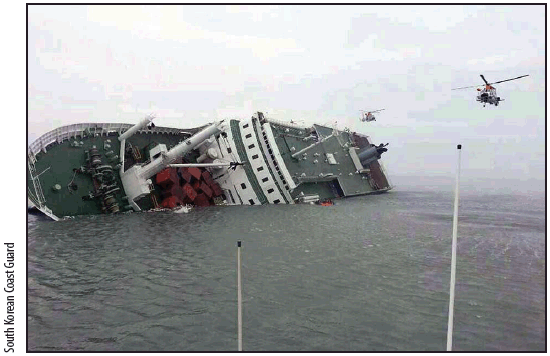You are here
Case Study of Maritime Disaster Yields Learning Tool
A new, two-part, teaching case study, Sinking of the Sewol: South Korea’s 2014 Ferry Disaster, was developed through Harvard’s John F. Kennedy School of Government. The case study may prove useful in courses that cover safety regulation, emergency response, crisis management, and transportation politics.
Written by Kirsten Lundberg and Soryoung Park for Arnold M. Howitt, Ph.D., the case can frame a challenging classroom discussion of a deeply flawed emergency response to the ferry incident and its subsequent sinking. It also allows graduate and advanced undergraduate students to probe the antecedents of the accident—including a number of safety violations—and follow subsequent events as the government’s handling of the maritime tragedy became a divisive national political issue and threat to the government of President Park Geun-hye. This research was funded by a U. S. Department of Transportation grant from the New England University Transportation Center to Harvard.
The first part of the case study describes how the tragic situation unfolded in a matter of hours. On April 15, 2014, the Sewol car ferry departed the port of Incheon, South Korea, on its twice-weekly, 300-mile overnight passage to the vacation island of Jeju. Of the 476 on board, 325 were 11th graders from Danwon High School in Ansan, accompanied by the vice principal and 13 teachers.
At 8:52 the next morning a student sent an initial distress call from the ship—it was listing badly. Other urgent calls followed—from the captain and crew, from students, and from the vice principal and teachers. These alerted various government agencies, Korea’s National Security Council, and the ferry company. But help arrived slowly and when on the scene proved inept.
Although the boat was sinking rapidly, for the next 90 minutes the captain and crew repeatedly advised passengers to remain below decks. Most complied; there was no order to evacuate. Only 1 of the 46 lifeboats on board deployed. Within an hour, a single Korean Coast Guard vessel and three helicopters arrived. The Coast Guard crew did not board the ferry, while tide and wind prevented smaller fishing boats from drawing alongside.
At 9:46 a.m., the ferry’s captain climbed into the Coast Guard boat along with other crew members. Passengers had still not been instructed to evacuate. At 10:31 a.m., the boat slipped under the surface.
The families, Administration, Korean Nation, and the world watched in anguish as rescue attempts continued to founder. Official updates changed constantly. The Korean Coast Guard put out inaccurate information about rescue attempts.
An early report erroneously claimed all aboard had been rescued. Then officials confused the “missing” with the “rescued” list. By the next morning, however, the grim numbers were clear: of the 476 on board, 172 were rescued. Of the 325 students, only 75 survived, and only 3 of the 14 teachers. However, of 33 crew members, 22 were rescued.
The second part of the case study, which tracks events following the incident, encourages classroom discussion on a range of questions. The search for a cause began instantly. Had the ship been overloaded? What was the safety record of Chonghaejin Marine and the history of the Sewol? Why was a third mate in charge during the trickiest part of the trip? Why did the captain abandon ship? Why did no one evacuate the passengers? What led to a situation in which rescue efforts were so inadequate? Who was or should have been in charge? Why were postaccident public information efforts so confused?
An investigation led to the arrest of the captain and several crewmembers 3 days after the incident. President Park’s administration and the regulatory framework for domestic maritime services also came under scrutiny. No single, stand-alone cause for the incident exists. The ferry’s owners bought the vessel used and renovated it in ways that left the vessel unstable. The company had neglected safety training of the crew, ship preparations, and briefing of passengers for emergencies. It had significantly overloaded the ship. Dockside workers and the crew had not secured cargo properly. An inexperienced officer was in charge during crucial maneuvers before the accident. Meanwhile, the Korean maritime safety regime had failed to deter or detect these problems.
Public outcry began immediately, harshly critical of President Park’s administration. Newspaper editorials, civic associations, politicians—and, quite prominently, the parents of the deceased high school students—denounced the company and the government for the failures that led to the accident and to the bungled rescue attempts.
Criticism increased when the President was perceived as too slow to express her concern and to accept responsibility for the government’s failures of regulation and rescue. Moreover, questions emerged around whether or not the country’s high-octane business culture played a role in the Sewol’s sinking.
In analyzing these defects, students can consider how a new safety regime might be constructed to ensure that vessels are compliant with regulations and prepared for emergencies. They can consider how the emergency response system might function more efficiently, with more streamlined communications. Lessons learned from a disaster halfway around the world and the flawed response to that disaster may help prevent a similar maritime tragedy closer to home.
About This Project
Arnold M. Howitt, Ph.D., (Arnold_Howitt@Harvard.edu) is Executive Director of the Ash Center for Democratic Governance and Innovation and Faculty Co-Director of the Program on Crisis Leadership at Harvard Kennedy School. He has conducted many previous UTC research projects and served on the New England UTC Policy Committee for more than 20 years. Kirsten Lundberg, formerly director of case programs at Harvard Kennedy School and Columbia University, now heads the Lundberg Case Consortium. Soryoung Park, a graduate of Harvard Kennedy School, MPP ‘14, has founded a media startup, PUBLY.

A rescuer tries to launch lifeboats aboard the ferry Sewol.

U.S. Marines assigned to the 31st Marine Expeditionary Unit responding to the scene of Korean passenger ship Sewol.

Helicopter rescue is under way as the Sewol sinks.
